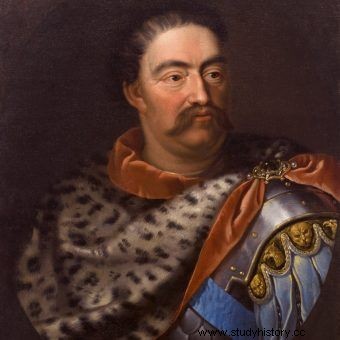
Jan III Sobieski
Jan III Sobieski
He was born on August 17, 1629 in Olesko, d. June 17, 1696 in Warsaw) - the King of Poland from 1674, the Grand Hetman of the Crown from 1668, the Field Hetman of the Crown from 1666, the Grand Marshal of the Crown from 1665, and the Grand Ensign of the Crown from 1656. The son of the castellan of Kraków, from 1649 he took part in battles with the Cossacks, including as part of the Zborów expedition. Heavily wounded in the battle of Beresteczek in 1651. In 1654, a member of the legation sent to Constantinople. During the Swedish Deluge Jan Sobieski he betrayed King Jan Kazimierz and turned over to the invaders. He only left the Swedish service after a few months. In the following years he fought with the Russians, Cossacks, Swedes and Transylvania. He joined the pro-French party and even received a salary from King Louis XIV. In 1665 he married the former court of Queen Louise Maria, Maria Kazimiera d'Arquien. In the same year, he was elected the Grand Marshal of the Crown, and a year later - the Field Hetman of the Crown. In 1667, he won a great victory at Pidhaitsi, breaking the overwhelming Turkish-Tatar forces. From 1668 he had the mace of the Grand Hetman of the Crown.
After Michał Wiśniowiecki was elected the new king, he openly spoke out against his rule. He was one of the leaders of the opposition known as the malcontents. Using subordinate troops, he aimed to overthrow the monarch. Winner from Khotyn in 1673.
The coronation of Jan III Sobieski
In 1674, after the death of Michał Korybut Wiśniowiecki, Jan III Sobieski was elected Polish king. In 1683, under a signed treaty of alliance, he set out to the rescue of the Habsburg capital. In the outskirts of Vienna, he was instrumental in defeating Kara Mustafa's Turkish forces. Then he won a great victory at Parkany. However, the war with Turkey did not bring Poland any lasting benefits, instead it radically strengthened Austria's position. The policy of King Jan III Sobieski also failed in contacts with Russia (Grzymułtowski's unfavorable peace) and in his Moldavian policy. Finally, he did not manage to implement the most important project for him:to put his son Jakub Sobieski on the throne.
Jan III Sobieski patron
Sobieski became famous as a patron of culture. He took care of talented architects (Tylman z Gameren, Andreas Schlüter, Augustyn Locci, Daniel Schultz, Jerzy Eleuter Szymonowicz-Siemiginowski), humanists (Wespazjan Kochowski, Joachim Pastorius, Wojciech Stanisław Chrościński, Jan Szulecki and the astronomer Jan Szulecki) , Adam Kochański). He induced and ennobled many of them. He has amassed a large library. He built a palace in Wilanów, founded a Capuchin church (as votum for the Victory of Vienna, where his heart rests) and the Church of St. Kazimierz in the New Town in Warsaw and the Royal Chapel in Gdańsk. He also rebuilt one of the tenement houses on the Lviv market square. He was a member of the world's first geographic society Accademia cosmografica degli argonauti , founded by the Venetian Franciscan Vincenz Maria Coronelli .
